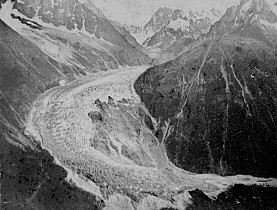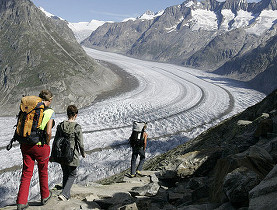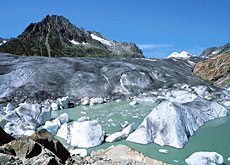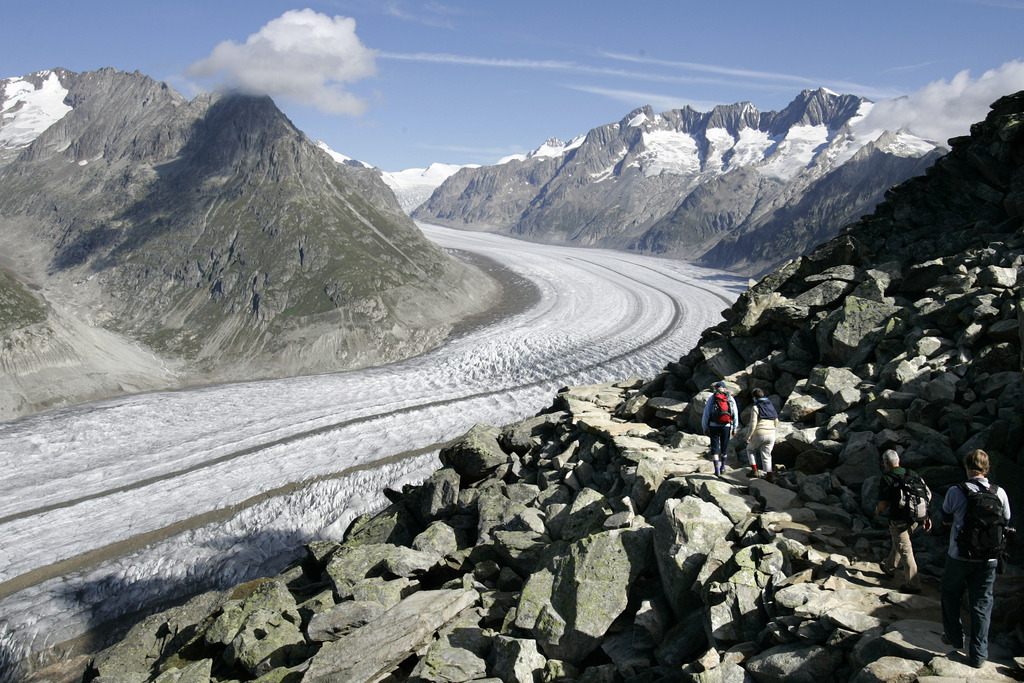An ice highway draws tourists and scientists

One of Switzerland’s most impressive landmarks is not only a favourite tourist attraction but also a useful indicator of climate change.
At some 23 kilometres in length, the Aletsch glacier is the largest in the Alps, and a major part of the Jungfrau-Aletsch-Bietschhorn Unesco World Heritage site.
If you take the cable car from the village of Fiesch in the Rhone valley, up to the Eggishorn you are rewarded with a breathtaking view. When you emerge from the upper station you find yourself looking down on a huge river of ice, flowing slowly from the Jungfrau region to the Massa gorge 2,500 metres below.
The Aletsch is not only the longest glacier, but also the one with the largest surface area. It is fed by ice that has formed more than 4,000 metres above sea level, and it finishes up flowing into one of Europe’s major waterways, the River Rhone.
The only larger glaciers in Europe are in the far north, in Iceland, and on islands of the Arctic Ocean: in the Norwegian archepelago of Svalbard, and Russian island group of Novaya Zemlya.
It is not only the length of the glacier, but its thickness which are impressive. Measurements carried out by the Federal Institute of Technology Zurich (ETHZ) have shown that at its source at the Konkordiaplatz it is about 900 metres thick. But as it descends it gets gradually thinner, and by the end its depth is only about 150 metres.
The total weight of the glacier has been calculated to be 27 billion tonnes – equivalent to 72.5 million jumbo jets. The water contained in it would be enough to give every person on the planet one litre a day for six years.
Ever changing
Three huge ice streams – already between seven and nine kilometres long – come together at the Konkordiaplatz. In merging they produce one of the striking features of the Aletsch: two dark stripes running practically all the way along the surface of the glacier. These are so-called medial moraines, consisting of the rock debris pushed down along the sides of the separate streams.
Over time medial moraines often create so-called glacier tables and dirt cones. A glacier table is a boulder perched on a pedestal of ice: by shading it from the sun, the rock slows down the rate at which the pedestal melts. A dirt cone is a cone of ice – which can be several metres high – covered by a thin layer of debris which again stops it melting as fast as the ice around it.
And something else even the casual visitor may notice: a yellowish band running along the rock on both sides of the valley immediately above the glacier surface. The light colour betrays the fact that the vegetation here is much more recent that that above it. The reason for that is that until not so very long ago the rock here was under the ice.
Slow retreat
All glaciers are subject to melting and freezing. They are formed when more snow falls than can thaw in summer. The snow is gradually compacted and eventually forms glacial ice. New ice is constantly being added at the top, while at the bottom it wears away, in a process known as ablation.
It is when the rate of ablation exceeds that of accumulation that a glacier starts to shrink.
Every year the Swiss glacier monitoring network reports on how far specific glaciers have retreated or advanced. But the figures must be treated with care, as Andreas Bauter, a glaciologist at the ETHZ told swissinfo.ch. On such a huge glacier as the Aletsch, the tongue reacts very slowly.
“The impact of occurrences in the lower parts of the glacier can quickly be seen at the tongue, but it takes about 50 years for signals from the Jungfraujoch to show up there,” he explained.
“You can’t attribute changes in the tongue directly to events of any individual year. Rather, they sum up what has happened over a period of about 50 years,” he said.
In fact, the measurements at the tongue vary considerably from one year to the next.
“The values for a single year don’t tell us very much,” said Bauter. “It’s only when you add them together, and see the trends, that you see that the glacier has been in retreat over the last 150 years.” And it is clear that the retreat has been greater in the past ten to 20 years than it was in the 1970s and 80s.
But in most of the last 10,000 years, the glacier was shorter than it is now. It is only in the last one or two thousand years that it has been relatively long.
For scientists the glacier is of great interest. But scientists are human beings too. Bauter has been there many times and is well aware of its dual attraction.
“When you can experience the forces of nature close to, I still find it spectacular. But of course, I look more closely, for particular things. I can never forget the scientific interest as well.”
Julia Slater, swissinfo.ch (with input from Gerhard Lob in Fiesch)
When it comes to records, glaciers can be measured by length, surface area or thickness.
The world’s longest glacier is the Lambert-Fischer in Antarctica, over 400km long and up to 50km wide.
Outside Antarctica, the world’s biggest mountain glacier is the Malaspina glacier in southern Alaska, about 45km long and 65km wide, with a surface area of 4,275km2.
The longest non-polar valley glacier is the Fedchenko glacier in the Pamir in Tajikistan, 77km long.
In Europe, the glacier with the largest surface area is the Austfonna ice cap on the Norwegian island of Nordaustlandet in the Svalbard archipelago, estimated at 8,120 km2.
The biggest in terms of volume is the Vatnajökull in Iceland, with an area put at 8,100 km2, and a depth of up to 900 m.
Glaciers and ice sheets cover a tenth of the Earth`s surface.
Alpine, or mountain, glaciers, like the Aletsch, form on mountain slopes.
An alpine glacier which fills an entire valley is called a valley glacier.
Glaciers which cover a mountain or mountain range are called ice caps or ice fields.
A tidewater glacier is one which terminates in the sea.

In compliance with the JTI standards
More: SWI swissinfo.ch certified by the Journalism Trust Initiative




You can find an overview of ongoing debates with our journalists here. Please join us!
If you want to start a conversation about a topic raised in this article or want to report factual errors, email us at english@swissinfo.ch.